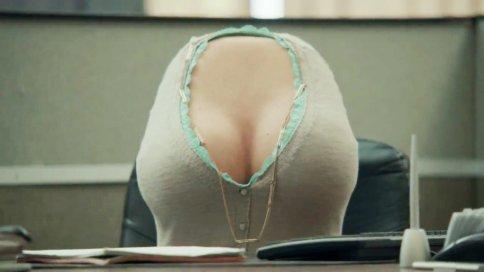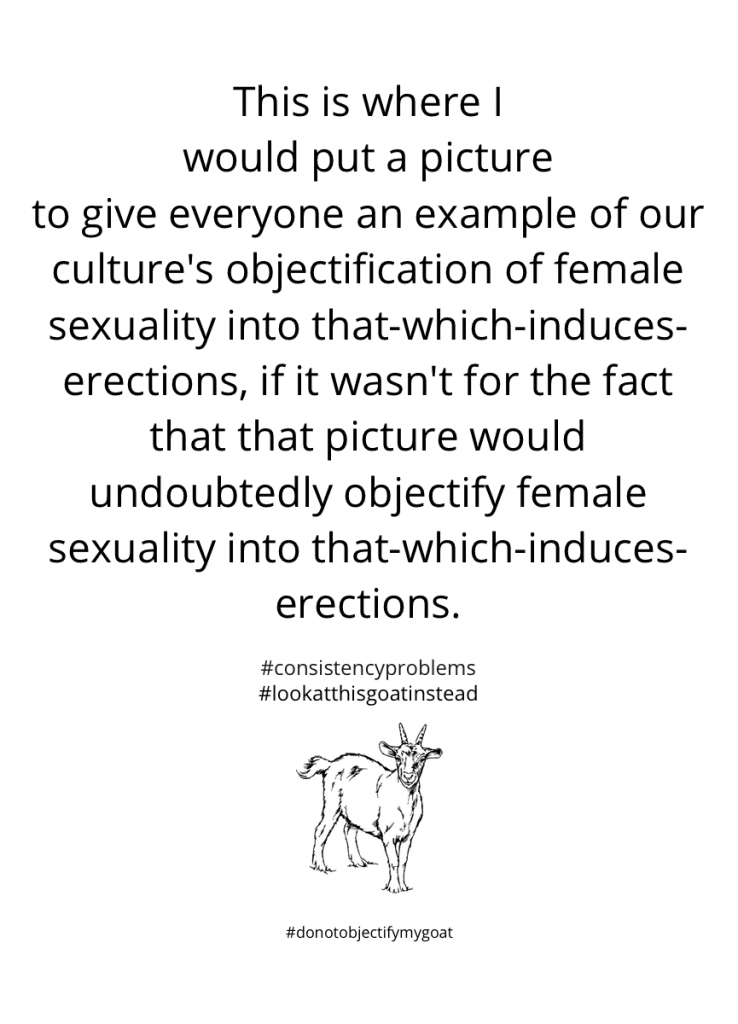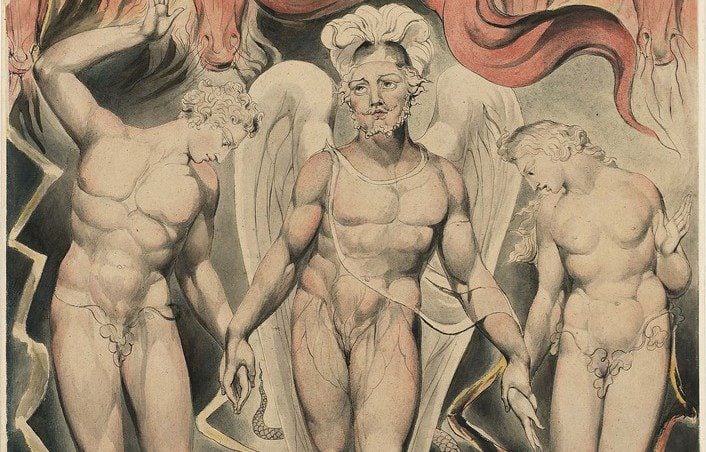When discussing purity as it relates to our awesome, sexually-liberated culture, it’s best to begin with a brief history of the female breast. The bosom has been through a lot, but allow me to point out its place in two distinct time periods, one Christian and one post-Christian.
According to the traditional feminist narrative, a heavily Christian culture that promotes purity — and even virginity — would be a culture busy repressing the hell out of the female breast, while a liberal, secularized, sexually-liberated society would be comparatively at ease with its display. Right?
So it is with some curiosity that we find that the very heart of Catholic culture gives us something like this:
In case it isn’t clear, the image depicts a grown man nursing from Mary’s breast. Now I understand this event — the Miraculous Lactation of St. Bernard, which occurred sometime mid-12th century — gives anti-Catholics a reason to chuckle, look up their favorite Freudian quotes, and otherwise label the whole thing as a phenomenon of repression. A grown man sucking a breast is, after all, entirely sexual, a turn-on even, and the fact that Catholics hold this mystical bit of awkwardness as an image of devotion is only further evidence that they need to get laid. Or something. And even Catholics themselves may recoil, blush, mutter something about metaphorical imagery and otherwise avoid the man at the breast. But whatever the worth of either reaction, neither was the reaction of the 12th century, which not only held the event and its depiction as beautiful, but saw so little shame in the vision that they depicted in their churches, using it as an image to direct the heart and mind to consider the Eternal.
My point is this: What for a Catholic age was beautiful is for our post-Christian age pornographic. What was once so self-evidently sacred that it inspired a deluge of depiction is now, and I think with equal “self-evidence,” a sexual fetish. Both ages view the female breast as sexual. But the Catholic is urged by his Holy Mother Church to view the breast as “sexual” in the true sense of the term, as pertaining to the female sex, as a physical expression of the reality of this or that particular woman, not separate from its function of nourishment, but not enslaved to it either — to see the breast as beautiful because it speaks of the person it belongs to. This makes sense of a culture for which the definition of chastity is “the successful integration of sexuality within the person.” (CCC 2338) It makes sense why there are more breasts in the Sistine Chapel and the Vatican Museum than in 20 years of Axe commercials.
(Obviously, I’ll be the first to call out any one who claims this was every Catholic man’s view of the breast. Men have objectified and pornographied ever since we’ve had the capacity for idiocy. However I do argue that, in a culture at the very least striving to see themselves and others through the clear waters of chastity, the Lactation of St. Bernard is not a source of ew but a source of meditation, and the female breast is seen in a far more holistic light than it is today.)
Which brings me to our current culture, for which the breast is certainly sexual, but only insofar as “sexual” means “that-which-induces-erections”, a sexuality known not by its shining expression of the whole woman, but by its effect on men. In our secularized, liberal culture — in which pornography is natural and healthy — the breast is liberated to the eye of sexualization. Breasts are used to judge the overall attractiveness of women, they are pushed in our direction every time sales of crappy light beer need a boost, they are the primary focus of the media’s camera, and in the bowels of Internet culture — I’m thinking of DeviantArt especially — the addition of a human pair of breasts to an animal of your choice makes that animal sexy.
In short, the world is comfortable with showing the female breast, just not as an integrated expression of the whole female to whom it belongs. The sexual revolution has liberated the female breast as a disintegrated expression of breasts because breasts, breasts as “hot” in themselves, erection-inducing items women happen to “have,” items — indeed — to which the woman is incident. This is entirely evident in the massive demand for breast enlargement surgery. It shouldn’t come as news to us that the ideal breast size for a woman is utterly impossible: Our culture demands women be simultaneously skinny and busty, and the truly “hot” woman is one with breasts that defy physics in their magical ability to be both massive and erect. The ideal breast, and the breast shown to our culture ad nauseaum, is a breast that stands apart from nature, Platonic in pornographic perfection, utterly divorced from the actual, whole, particular woman for whom her breasts are — in reality — but a part. These men want, and these women strive for, compelled by the male gaze to pump silicone into their breasts until they balloon as stiff as Gulag prisoners lined up inspection. What else can we do when our sexual parts are no longer a reflection of ourselves, but now stand shining in their own right, a part more important than the whole? What else besides exaggerate them at the expense of any proportion within the whole human body?

So perhaps a post-Christian age bares its bosom at a greater rate than the old, patriarchal age of Christianity. But where a Christian age revealed the breast in comfort, a post-Christian age does so in desperation, for while the promotion of chastity is the promotion of integration, the brave rejection of chastity — couched as embrace of freedom — is really an embrace of disintegration. What else can be said of culture in which women are simultaneously frowned upon for breast-feeding in public and told, in a myriad of situations and for innumerable ends, “tits or GTFO.”
It may be very true that the Holy Mother Church puts limits on the display of breasts. She demands we do not display female breasts as divorced from the expression of the true, beautiful, female self of which they are a part, and of which they are an expression. Her one limit is that we do not limit ourselves. Her one objection is that we work to show all of us, and thus her “no” to pornography, sexting, and stripping is not a slut-shaming that represses the free choices of girls, but a “yes” to the entire body, and thus to the entire person. She simply asks that such decisions be the decisions of the entire girl.
as divorced from the expression of the true, beautiful, female self of which they are a part, and of which they are an expression. Her one limit is that we do not limit ourselves. Her one objection is that we work to show all of us, and thus her “no” to pornography, sexting, and stripping is not a slut-shaming that represses the free choices of girls, but a “yes” to the entire body, and thus to the entire person. She simply asks that such decisions be the decisions of the entire girl.
What our culture does with the breast, it is steadily doing to the entire female body, defining every physical expression of female sexuality as only sexual in its effect upon the male penis, whether the mouth, rear, neck, or feet, whether breast-feeding or bathing, being skinny or fat. My heart goes out to girls born into a culture busy crossing out the remaining body parts and gestures yet to be pornographied. Pornography — whether hardcore or softcore, in media or in advertising, in strip-clubs or on cell phones, subtle or blatant — this is America’s real comprehensive sex education, had we the balls to admit it, and by it we are educated to look at women as combinations of disintegrated sexual parts.
Now in her excellent work, Female Purity is Bullshit, Lindy West argues that our concept of purity is sexist.
This entire “conversation” is just an effort to rig a system in which men get to determine female worthlessness no matter the input. There is nothing you can do to be pure. Meanwhile, they get to do literally whatever they want with anyone, to anyone, at any time. The double standard is so blatant it’s almost too boring to point out.
Again, I find myself in agreement. Expectations of “purity,” “virginity,” “modesty,” and “chastity” fall almost exclusively on women, in telling proportion with words describing unchastity — like “slut” and “whore.” West, taking the voice of a purity-enforcing man, explains rather clearly why this is the case:
I struggle with the same powerlessness and insecurity that all human beings do, so as a coping mechanism I take advantage of our culture’s patriarchal power structure and exorcize my feelings of worthlessness by perpetuating shame-based proprietary attitudes over women’s bodies. Basically I’m obsessed with controlling women’s lives because I can’t control my own.
Maybe, but I think the reason the “purity culture” is sexist — while not excluding West’s reasoning entirely — is a little deeper than just “guys like being assholes.” “Purity” is not just another chain to control women. It’s a bad reaction to a bigger chain, an unthought, unhelpful rebellion against a choking, thorny, bind that has women by the throat, a bind West mentions, but does not understand to be the motive for vague, controlling definitions of “purity:”
We condition girls (explicitly! Not even covertly!) to believe that if they’re not sexually attractive, they’re nothing. They’re garbage. They might as well not exist.
This is why “purity culture” is sexist. Our “purity culture” takes for granted the idea that purity is an absence — an absence of sex, an absence of sexy mannerisms, and absence of sexy clothes, etc. — and then asks the world to follow it. But meanwhile, back on the ranch, the world has made almost every characteristic of women an erection-inducing characteristic. So of course the weight of “purity” falls far more heavily on women. The demand for an absence-of-erection-inducing-sexuality finds in objectified women far more to demand an absence of. Any expectation of purity described primarily as an absence of sexuality will naturally fall most heavily on the most “sexualized, ” and the man who wishes a woman to “cover up” at the expense of her good, normal expression of sexuality is a man who has been educated — not by Christianity, but by an essentially pornographic culture — to believe that a normal expression of sexuality is and must be erection-inducing.

The Catholic Church — and I don’t have the time to pretend I’m not furiously proud of her philosophy — has the answer, and its the same answer that has her churches full of beautiful nudes, male and female. By defining chastity not as an absence, but as an essentially human project, the virtue weighs no more heavily on women than men. Chastity calls everyone to the easy and terrifying yoke of becoming precisely the self they are, saying that “everyone, man and woman, should acknowledge and accept his sexual identity,” (CCC 2333) begging we strive after “the successful integration of sexuality within the person” (CCC 2337) that “eminently personal task” (CCC 2344) with the goal that all people, men and women, may own themselves. The Church, by rejecting negative definitions of purity, rejects the sexism which is a natural response of a “purity culture” to a “pornographic culture.” (This is besides the fact that she rejects the all-encompassing, false sexualization of women that leads to a sexist “purity” in the first place.)
The reason West doesn’t seem to consider that the sexism poisoning the “purity culture” is part of a larger sexism may be because mainstream feminism has its hands far too dirty for comfort. Though we’d like to pretend that those advocating for female equality have been diametrically opposed to a worldview that promotes the false-sexualization of women, the reality is that the promotion of pornography — which educates men to see women as “sluts” for whom no body part, no action, no banal situation, career, or clothing cannot be disintegrated into something erection-inducing — has found a hero in feminism. Mainstream Jezebel-esque feminism, far from decrying objectification, has twisted itself into knots advocating feminist porn, seeking the surface-level goods such as the proper treatment of sex workers (an oxymoron) and criticism of mainstream porn, but ultimately perpetuating a culture that objectifies the human body by its very nature, displaying its every inch to a third-party as entirely divorced from the person, divorced from the infinite human subject for which it is a physical expression, divorced even from sexuality, for it is not sexuality-as-personal-revelation, but sexuality-as-useful-for-arousal.
West wishes to combat the sexism of “purity” by telling girls to “fuck what you like, when you like,” arguing that actions considered “slutty” aren’t bad, “sending naked pictures of yourself is an inherently ‘bad’ thing to do. Nudity isn’t bad. Sex isn’t bad. Nipples aren’t bad. Even chastity isn’t bad. Literally all of this shit is arbitrary.” Her answer to a culture which judges women’s sexual actions is to divorce all sexual actions from a meaningful realm.
West is oriented in the right direction, in that she wishes to place the source for female worth not in a woman’s action, but in the woman herself. The problem with West’s answer, which is the primary answer of mainstream feminism, is that it chokes itself. By telling women that their actions have no meaning, she inadvertently promotes a culture which has lead to our pornographication of women and thus to the very “purity culture” she and I detest. Men are being educated to see women as a pair of breasts, reducible to a series of pixels, and available-on-command, and from this sexism comes the sexism of the “purity culture.” Thus, “sending naked pictures of yourself” is not a meaningless act, but an act that perpetuates the cycle of sexism, the cycle which determines the worth of women by that oh-so-finite amount which can be expressed in a naked picture.
My fundamental issue with mainstream feminism is not its complaint. Its complaint is valid. My fundamental issue is that despite the drive to hold men accountable for our reductionist views of women, feminism promotes the reduction of women by women as a morally irrelevant. It is a moral evil and a detestable act of cowardice for a man to view a woman as a pair of breasts, but a woman taking naked pictures of herself is an act that transcends good and evil in perfect freedom. We are to simultaneously support pornography and an end to the pornographication of women. It’s incomplete and self-defeating. What’s needed is a fuller view, an understanding not just of a woman’s right to be viewed as her self — which feminism boldly proclaims — but every human being’s responsibility to become themselves, to live as themselves, and to act as their true selves, a responsibility over which mainstream feminism has fallen silent.
This balance of right and responsibility, the lack of which has lead to no discernible improvement in our culture’s view of women, is once again held by the Catholic Church. More on that next time.













